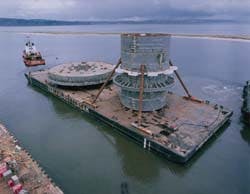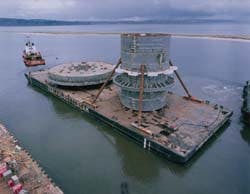SUBSEA TECHNOLOGY Schematic of the proposed Aesop seabed processing module.
All-electric seabed processing holds promise for marginal fields
ATE's REAct provides failsafe electric actuation of the subsea tree and shutdown valves in Prime.
Oil company funds are being sought to help develop an electrical control and power distribution system for remote seabed processing.
Alpha Thames Engineering (ATE), based near London, is also applying for a 2 million grant towards constructing a prototype through the European Community's Thermie programmed: it already has backing from Britain's OSO. AESOP (the all-electric seabed oil processing system) would be the next stage in the development of ATE's Prime subsea single-phase separation and pumping system.
Prime and its associated products have had 4 million of investment since it was first conceived in 1989. This is a modular system: modules such as the liquid/gas separator, booster pumps, control and injection modules, pigging, gas lift, water injection and manifolding facilities can be packaged in a variety of configurations to suit different field requirements. The system can be tied back to floating production or fixed platforms up to 50 km away, with installation and retrieval for repair or eventual decommissioning designed to be fully diverless.
Prime basically involves taking product from one or more wells and, following manifolding, separating the gases from the liquid. Gas and liquid are then routed separately to the host platform, with only the liquid phase requiring pumping.
The system was originally designed with multiplexed electro-hydraulic controls for single-phase separation. However, ATE feels that an all-electric system would give greater control than multiplexing, where some of the hydraulics have to be incorporated in the subsea system.
The prevailing industry view of the early 1990s was that multiphase pumping was the way forward for long-distance subsea production. However, the drawbacks of multiphase have yet to be convincingly overcome.
ATE points out that handling throughput of up to 20,000 b/d from producer and water injector wells would require very high power multiphase pumps (1-5 MW) governed by complex speed control systems. Frequent shutdowns are likely, as pumping quantities of wet gas through a multiphase line often leads to hydrate build-up.
AESOP, by contrast, would offer very simple first stage separation driven by much smaller pumps (150-200kW), with no need for speed control.
The aim - subject to EU funding - is to start construction of the prototype system this year. Thermie's 2 million represents 40% of the estimated cost of the two-year project. Oil companies are being invited to make contributions of 25,000 each per year: the first company to place an order will have the prototype AESOP module designed and constructed to suit the field of their choice.
On completion of the project, that company will be offered the module at 60% of the project cost. Other sponsors would receive fully documented results.
Automated connections
Diverless operations with Prime are made possible through CUSP, a multipurpose ROV-operated connection system for pressure connections of rigid or flexible flowlines, bundles, electro-hydraulic umbilicals, valve installation and retrieval and pipeline repairs. CUSP, also designed by ATE, aligns pipeline ends then clamps and seals in a single operation through one linear hydraulic operation. The design incorporates a flowline pull-in system, operating within tolerances of +/- 25mm. Babcock Energy in Glasgow made the prototype CUSP: now ATE is looking for another manufacturer on a commercial basis.
High voltage electrical connectors (up to 11kV) for the pumps are made by Hydro-Bond Engineering, Aberdeen under licence to ATE. The Hydro Webb Connector overcomes the problems of water ingress by adopting an innovative insulation technique. The connector is mated in insulating liquid, as with existing designs; however, once mating has been achieved, the liquid around the electrical contacts is drained away and replaced with air at atmospheric pressures within a sealed chamber.
Other accessories developed by ATE for Aesop include REAct, a failsafe electric valve actuator for the subsea tree and shutdown valves, which removes the hydraulic element of subsea umbilicals and thereby lowers system cost. ATE claims the actuator gives immediate response and greater flexibility of control. REAct's failsafe mechanism operates on loss of power or emergency signal; it has a full manual/ROV override facility.
The fourth component in the package is MATE, a multiple pipework connector that allows simultaneous connection/disconnection of up to six 8-in. and five 4-in. lines. Both halves of the connector are internally valved to contain process fluids when separated.
The high voltage power underwater mateable electrical connector is to be tested by GEC Alsthom in the SPEED trials at Rosyth Scotland.
ATE has identified up to 60 marginal fields in the UK alone - most close to existing platforms - which would be candidates for this technology. For a 75MM bbl field with throughput of 10-30,000 b/d, tied back 30 km to a platform, it estimates development costs at 100-130 million. Two-thirds would be spent on laying the flowlines and drilling two producer and two water injector wells. But the aim is to reduce installation costs for the processing system to A7-10 million.
Copyright 1996 Offshore. All Rights Reserved.

